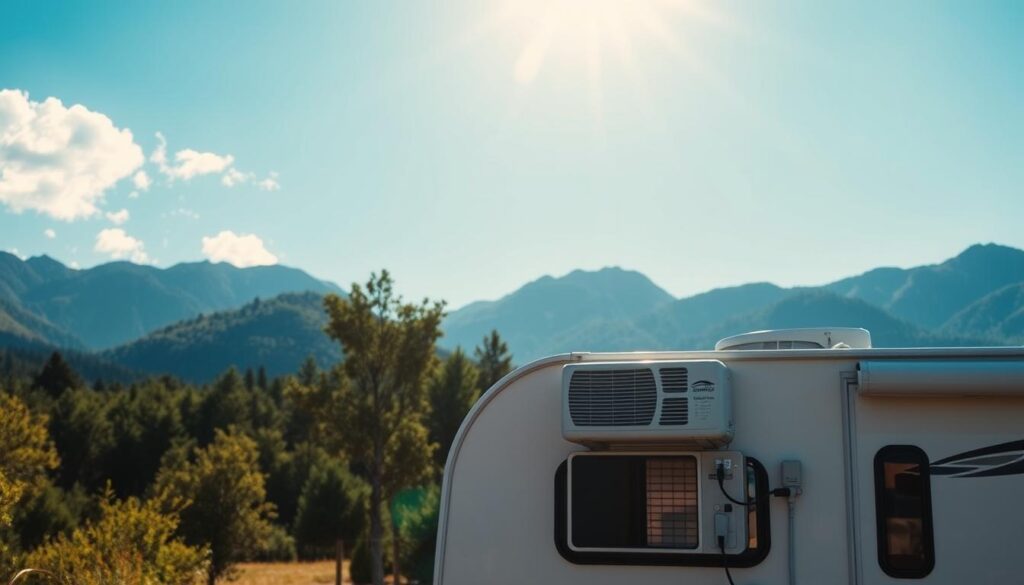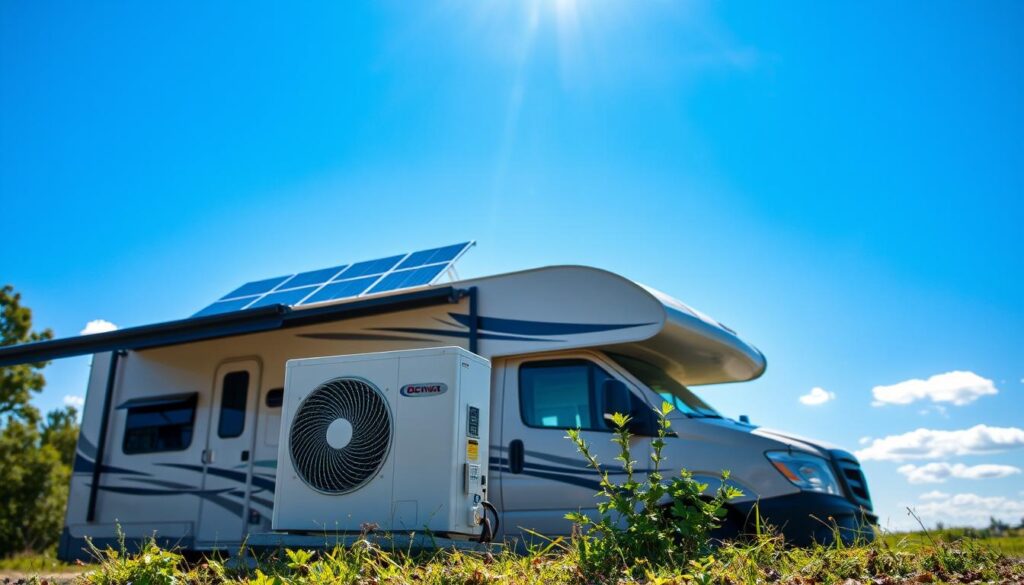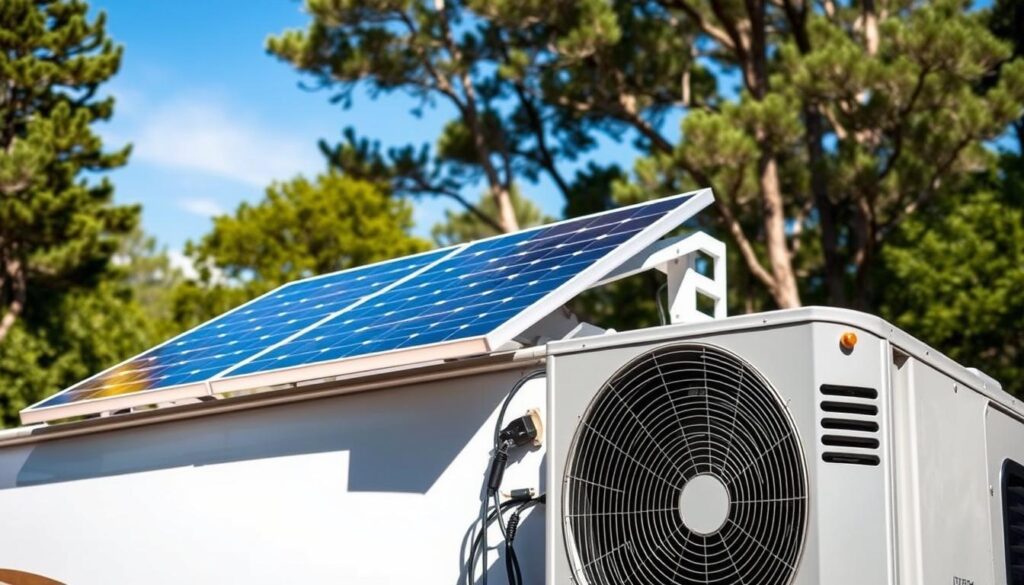Physical Address
304 North Cardinal St.
Dorchester Center, MA 02124
Physical Address
304 North Cardinal St.
Dorchester Center, MA 02124
I’ve always been fascinated by using solar power for RV air conditioners. It’s a great way to cut down on costs and upkeep. An RV air conditioner needs about 1800 watts to start and 650 watts to keep running. A big enough solar system is key to meet these needs.
Using solar power for RV air conditioners has many benefits. It can lower the cost of fuel and electricity and is good for the environment. But, the initial cost of solar panels, batteries, and installation can be high. Companies like ShopSolar.com have helped over 40,000 customers, showing it’s a growing field.

In this guide, I’ll look into making an RV air conditioner run on solar power. With the right solar panels, batteries, and inverter, it’s doable. I’ll show you how to pick and install the right parts for the best performance.
To figure out how much solar power you need for your RV air conditioner, first look at its power use. RV air conditioners use watts (W) or amps (A). Multiply the power rating by 1.25 to account for system losses. This will show you how big your solar system needs to be.
When thinking about solar power for RV air conditioner, several things matter. The air conditioner’s size, how long you use it, and its energy efficiency are key. For example, a 13500 BTU RV air conditioner needs about 1 to 1.5 kW of energy each hour. To power it with solar power for RV air conditioner, you must consider the solar panel’s wattage, battery size, and the air conditioner’s energy use per hour.

Important things to think about for solar power for RV air conditioner include:
By understanding these points and calculating your needs, you can make sure your RV air conditioner works well on solar power for RV air conditioner.
For solar power for rv air conditioner, several key parts work together. These include solar panels, a battery bank, an inverter, and a control system. Solar panels make electricity from sunlight. This electricity is stored in the battery bank for later use.
The inverter changes the DC power from the solar panels and battery bank into AC power. This AC power runs the air conditioner.
The size and type of solar panels needed depend on the air conditioner’s BTU rating and how often it’s used. For example, a 12,000 BTU air conditioner might need a solar array that makes about 1800 watts of solar energy. The battery bank should hold around 700-800 amp hours (AH). This setup can power the air conditioner for 8 hours a day.

A good inverter and control system are also key for a solar-powered RV cooling system. The EcoFlow Power Kit, for instance, can output 3600W. This is enough to power an RV air conditioner. It uses 48V power, which reduces energy loss and heat compared to 12V systems.
Using solar power for rv air conditioner has many benefits. It lowers maintenance costs, has less environmental impact, and is more energy efficient. With a well-designed solar power system, RV owners can cool their RV efficiently and cut down on traditional energy use.
| Component | Description |
|---|---|
| Solar Panels | Generate electricity from sunlight |
| Battery Bank | Store excess energy for later use |
| Inverter | Convert DC power to AC power |
| Control System | Monitor and manage the solar power system |
Choosing the right solar panel setup for your RV air conditioner is key. The size of the solar array depends on your RV’s size and energy needs. A system that generates about 1800 watts of solar power and 700-800 amp hours from the battery can run an air conditioner for about 8 hours a day.
To find the perfect setup, consider the types of solar panels for RVs. These include monocrystalline, polycrystalline, and thin-film panels. The placement of panels is also critical for optimal performance.
Factors like roof space, shading, and angle for maximum sun exposure are important. I explain how to figure out the number and size of panels needed. This depends on the air conditioner’s power needs and daily use.
Monocrystalline panels are the most efficient for RVs, with efficiency rates of 15–20 percent. Amorphous panels, on the other hand, can lose up to 30 percent of their power in the first year. Knowing the pros and cons of each type is essential for making a good choice.
For the best performance, it’s vital to place the panels correctly. This means considering the RV’s roof space, any shading, and the best angle for sunlight. By optimizing panel placement, you can ensure your solar setup works at its best.
For solar power for rv air conditioner, a good battery bank is key. It stores extra energy from solar panels. Lithium-ion batteries are best for RVs because they pack more energy and can be used more than lead-acid batteries.
To find the right battery size, think about your RV air conditioner’s power use and how long you want it to run. A 600-amp hour lithium battery system is a good start. It can power an RV air conditioner for about 6 hours. Here’s a rough guide to battery size for different air conditioner powers:
| Air Conditioner Power | Battery Capacity |
|---|---|
| 1000 watts | 200-400 Ah |
| 1500 watts | 300-600 Ah |
| 2000 watts | 400-800 Ah |
The actual battery size needed might change based on a few things. These include solar panel efficiency, inverter quality, and wiring setup. Getting the battery and solar panel sizes right is important for the system to work well.
Choosing the right battery and setup for your solar power for rv air conditioner brings many benefits. You get energy freedom, save money, and help the environment. Plus, your RV stays cool and comfy.
Installing solar power for rv air conditioner needs careful planning. First, figure out your daily power use in watt-hours. Note the power use of each device and how many hours a day you’ll use them.
Choose panel wattage 1.3 to 1.5 times your daily needs. This helps with cloudy days and charging issues. Opt for lithium-ion batteries for their long life, light weight, and deep discharge.
Here are important steps for the installation:
By following these steps and considering your RV air conditioner’s needs, you can install your solar power for rv air conditioner system safely and efficiently.
| Component | Description |
|---|---|
| Solar Panels | Convert sunlight into electrical energy |
| Charge Controller | Regulate current and prevent overcharging |
| Battery Bank | Store excess energy for later use |
To get the most out of your solar power for rv air conditioner, managing power is key. Using energy-saving appliances and natural air flow helps a lot. For example, LED lights use much less power than regular bulbs. A 10W LED light uses about 0.15 kWh every day.
Another smart move is to keep your RV cool. This makes your air conditioner work less hard. Use reflective window covers and park in the shade. Also, a programmable thermostat can save energy by controlling when the air conditioner runs.
Keeping your solar and air conditioner systems in top shape is vital. Clean the solar panels, check the air conditioner’s filters, and make sure the battery is full. These steps help cut down on power use and boost your solar power for rv air conditioner system’s efficiency.
Here are some tips for better power management:
By following these tips, you can enjoy a cool and green solar power for rv air conditioner system. Plus, you’ll be doing good for the planet.
When dealing with solar power for RV air conditioners, it’s important to troubleshoot. This ensures your system works well and lasts long. Common problems include dirty solar panels, loose connections, or faulty parts.
Regular maintenance is key. Clean your solar panels and check wiring connections. Also, watch how much energy you use and make in different weather. Your solar array should make at least 50% more energy than you use to keep your air conditioner running.
Power issues can be low voltage, bad charge controllers, or too small solar panels. To fix these, check your solar panel voltage, make sure your charge controller works, and ensure your solar panels are big enough for your RV’s needs.
System problems can come from weather, battery health, or electrical failures. To solve these, keep an eye on how your system performs, check your battery water, and look at your electrical connections. This way, you can find and fix problems early.
By following these tips and keeping up with maintenance, RV owners can have cool and reliable air on the road. Remember, regular checks and upkeep are vital to avoid common problems and keep your system running smoothly.
Thinking about getting a solar power for rv air conditioner? It’s key to look at the cost and return on investment (ROI). The upfront cost of a solar system is high. But, it’s worth it when you think about saving money on fuel and maintenance over time.
The size of the solar array and battery bank matters a lot. You’ll need solar panels that can give over 2000 watts per hour. A big battery bank is also needed to power the RV’s electrical needs. These costs can seem high at first. But, the long-term savings are big.
When thinking about ROI, consider a few things:
Also, think about the non-monetary benefits. Like having more energy independence and helping the environment. When I’m thinking about getting a solar power for rv air conditioner, I’m balancing the initial cost against the long-term savings and benefits.
Getting a solar power for rv air conditioner means using less fossil fuel. It also helps the planet. With the right setup, you can enjoy solar power and reduce your environmental impact.
Using the sun to power your RV’s air conditioner is now a real option. Thanks to new solar tech, managing your solar power for rv air conditioner is easier than ever.
Think about your energy needs, pick the right solar panels, and get a good battery. This way, you can have a solar power for rv air conditioner system that keeps you cool. It’s a great way to live off the grid and enjoy the outdoors.
Starting might cost more, but the long-term gains are worth it. You’ll save money, use less energy, and help the planet. So, when planning your next RV trip, think about using solar power. It will make your adventure more comfortable and sustainable.
Yes, you can power an RV air conditioner with solar energy. You’ll need the right solar panels, batteries, and other parts. This way, you can run your RV air conditioning using the sun’s power.
You’ll need solar panels, a battery bank (like lithium-ion), an inverter, and a charge controller. These parts work together to power your RV air conditioner.
First, think about your air conditioner’s size, energy use, and how often you use it. This info helps you choose the right solar panels and batteries.
RVs often use monocrystalline, polycrystalline, or thin-film solar panels. The best choice depends on your roof space, efficiency needs, and budget.
The battery bank is key. It stores energy from the sun for when you need it. Lithium-ion batteries are best because they hold more energy and can be used more deeply.
Use energy-saving appliances and a programmable thermostat. Also, keep your RV cool and maintain your solar system and air conditioner well.
The cost varies based on the size of your solar panels, batteries, and other parts. But, the long-term savings on fuel and maintenance can make up for the initial cost.